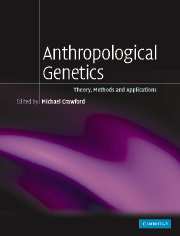Book contents
- Frontmatter
- Contents
- List of Contributors
- Preface
- Chapter 1 Foundations of Anthropological Genetics
- Part 1 Theory
- Part 2 Methods
- Part 3 General Applications
- Part 4 Part IV The Human Diaspora
- Chapter 12 Human Origins Within and Out of Africa
- Chapter 13 The Peopling of Europe
- Chapter 14 The Peopling of Oceania
- Chapter 15 The Prehistoric Colonization of the Americas
- Chapter 16 Anthropological Genetics: Present and Future
- Index
- References
Chapter 15 - The Prehistoric Colonization of the Americas
Published online by Cambridge University Press: 05 June 2012
- Frontmatter
- Contents
- List of Contributors
- Preface
- Chapter 1 Foundations of Anthropological Genetics
- Part 1 Theory
- Part 2 Methods
- Part 3 General Applications
- Part 4 Part IV The Human Diaspora
- Chapter 12 Human Origins Within and Out of Africa
- Chapter 13 The Peopling of Europe
- Chapter 14 The Peopling of Oceania
- Chapter 15 The Prehistoric Colonization of the Americas
- Chapter 16 Anthropological Genetics: Present and Future
- Index
- References
Summary
An old problem
America's ‘discovery’ by the Europeans of the fifteenth century posed a question: who were the strange people who inhabited the land? A papal bull from Paul III (1468–1549) solemnly recognized in 1537 their human status. Since they were humans they could only be descendants of Adam and Eve, more specifically of Noah's grandchildren. Arias Montanus was able to find a resemblance between the words Peru and Ophir, one of Noah's descendants, therefore setting the question of their origin, at least in biblical terms (Pericot y García, 1962; Lavallée, 2000)
Equally bizarre was Florentino Ameghino's contention that all humanity had originated from the Argentinian Pampean region. Most of these suggestions or hypotheses that were put forward before the twentieth century or early in the 1900s have now only historical (or mythological) interest. Some of them have been summarized in Salzano and Callegari-Jacques (1988) and Crawford (1998). Since no paleoanthropological findings of high antiquity were found in America the questions were centred on three basic issues: (a) from where did the Amerindians come? (b) how many waves of immigration occurred?, and (c) when did they arrive? Researchers from different disciplines considered these questions and diverse, sometimes contradictory answers had been made. They will be considered in the following sections.
The colonization process: non-genetic evidences
Geology and archaeology
The present consensus is that the prehistoric colonization of the New World should have occurred via the Bering Land Bridge, formed as a result of lower sea levels which were present there at the time.
- Type
- Chapter
- Information
- Anthropological GeneticsTheory, Methods and Applications, pp. 433 - 455Publisher: Cambridge University PressPrint publication year: 2006
References
- 1
- Cited by



